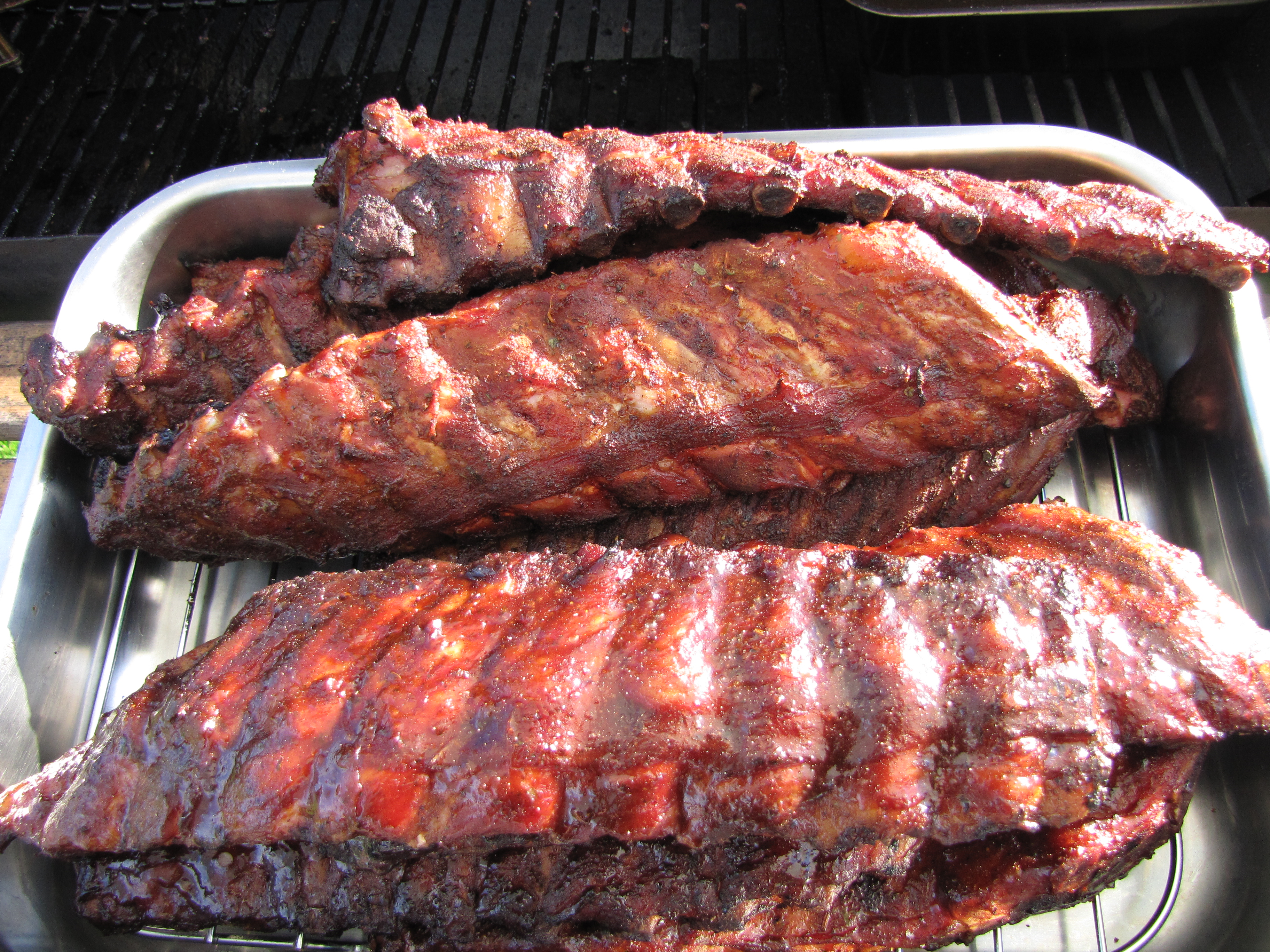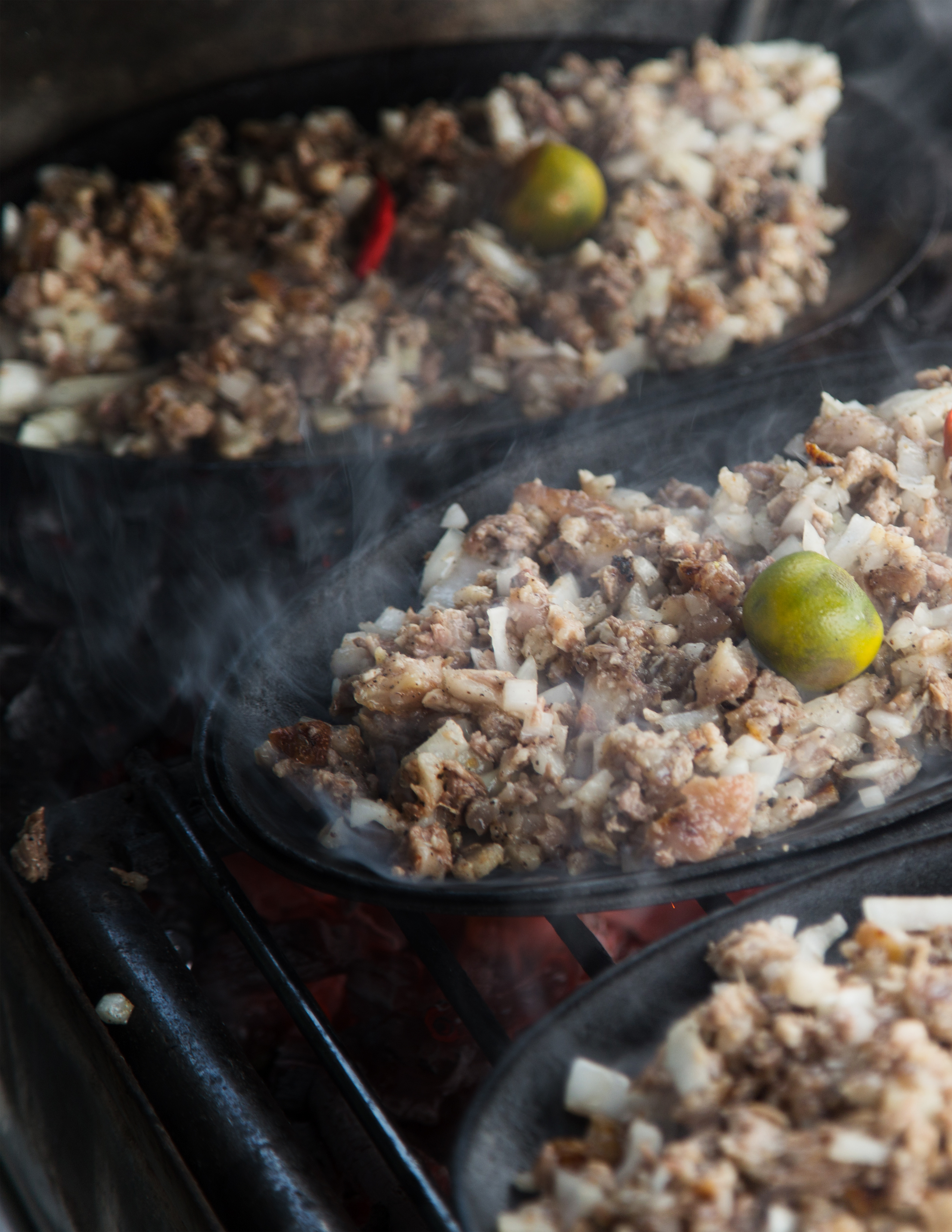|
Livermush
Livermush is a Southern United States pork food product prepared using pig liver, parts of pig heads, cornmeal and spices. It is a regional cuisine that is common in Western North Carolina, and is typically consumed as a breakfast and lunch food. It has been suggested that livermush derives from scrapple. By law in North Carolina, the product must consist of at least 30% pig liver. Several festivals exist in North Carolina that are dedicated to the food. Though sometimes considered the same as liver pudding, livermush generally contains more cornmeal and is coarser in texture. It is generally prepared using a different recipe than for liver pudding. Overview Livermush is composed of pig liver, pig head parts such as snouts and ears, cornmeal and seasonings. It is commonly spiced with pepper and sage. The meat ingredients are all cooked and then ground, after which the cornmeal and seasoning is added. The final mixture is formed into blocks which are then refrigerated. It typic ... [...More Info...] [...Related Items...] OR: [Wikipedia] [Google] [Baidu] |
Goetta
Goetta ( ) is a meat-and-grain sausage or mush of German inspiration that is popular in Metro Cincinnati. It is primarily composed of ground meat (pork, or sausage and beef), pin-head oats and spices. It was originally a dish meant to stretch out servings of meat over several meals to conserve money, and is a similar dish to scrapple and livermush, both also developed by German immigrants. Origins and popularity The dish probably originated with German settlers from the northwestern regions of Oldenburg, Hannover, and Westphalia who emigrated to the Cincinnati area in the 19th century. Along with Cincinnati chili and mock turtle soup it is, according to Cincinnati food historian Dann Woellert, one of the area's "holy trinity" of local specialties. The first commercial producer was Sander Packing. Composition While goetta comes in a variety of forms, all goetta is based around ground meat combined with pin-head oats, the "traditional Low German cook's way of stretching a mini ... [...More Info...] [...Related Items...] OR: [Wikipedia] [Google] [Baidu] |
Shelby, North Carolina
Shelby is a city in and the county seat of Cleveland County, North Carolina, United States. It lies near the western edge of the Charlotte combined statistical area. The population was 20,323 at the 2010 census. History The area was originally inhabited by Catawba and Cherokee peoples and was later settled between around 1760. The city was chartered in 1843 and named after Colonel Isaac Shelby, a hero of the battle of Kings Mountain (1780) during the American Revolution. Shelby was agricultural until the railways in the 1870s stimulated Shelby's development. Textiles later became its chief industry during the 1920s when production of cotton in Cleveland County rose from 8,000 to 80,000 bales a year. Cotton production peaked in 1948 with Cleveland County producing 83,549 bales, making it North Carolina's premier cotton county. In the 1930s, Shelby was known as “the leading shopping center between Charlotte and Asheville” People from surrounding counties came to Shelby to ... [...More Info...] [...Related Items...] OR: [Wikipedia] [Google] [Baidu] |
Pig's Ear (food)
Pig's ear, as food for human consumption, is the cooked ear of pig. It is found in several cuisines around the world. Human consumption Bulgarian cuisine In Bulgaria, a pig's ear is used as an appetizer for beer or wine. It is first boiled and then grilled with lemon, soy sauce, salt, and ground pepper. Chinese cuisine General In Chinese cuisine, pig's ear is often an appetizer or a side dish, called 豬耳朵 (pinyin: ''zhū ěr duo'', "pig's ear"), often abbreviated to 豬耳 (pinyin: ''zhū ěr''). In some regions, pig's ears are known as 层层脆 (''ceng ceng cui'', literally "layers of crunch"). It can be first boiled or stewed, and then sliced thin, served with soy sauce, or spiced with chili paste. When cooked, the outer texture is gelatinous, akin to tofu, and the center cartilage is crunchy. Pig's ear can be eaten warm or cold. Cantonese cuisine In Cantonese cuisine, it is another ingredient used in lou mei. The emphasis is on using all edible parts of the ... [...More Info...] [...Related Items...] OR: [Wikipedia] [Google] [Baidu] |
List Of Pork Dishes
This is a list of notable pork dishes. Pork is the culinary name for meat from the domestic pig ('' Sus domesticus''). It is one of the most commonly consumed meats worldwide,Raloff, JanetFood for Thought: Global Food Trends Science News Online. May 31, 2003. with evidence of pig husbandry dating back to 5000 BC. Pork is eaten both freshly cooked and preserved. The consumption of pork is prohibited in Judaism, Islam, and some Christian denominations such as Seventh-day Adventism. Fresh pork may contain trichinosis, a parasitic disease caused by eating raw or undercooked pork or wild game infected with the larvae of a species of roundworm '' Trichinella spiralis'', commonly called the trichina worm. In the United States, the U.S. Department of Agriculture recommends cooking ground pork, that is obtained from pig carcasses, to an internal temperature of 160 °F, followed by a 3-minute rest, and cooking whole cuts to a minimum internal temperature of 145 °F, also fo ... [...More Info...] [...Related Items...] OR: [Wikipedia] [Google] [Baidu] |
Appalachian Mountains
The Appalachian Mountains, often called the Appalachians, (french: Appalaches), are a system of mountains in eastern to northeastern North America. The Appalachians first formed roughly 480 million years ago during the Ordovician Period. They once reached elevations similar to those of the Alps and the Rocky Mountains before experiencing natural erosion. The Appalachian chain is a barrier to east–west travel, as it forms a series of Ridge-and-Valley Appalachians, alternating ridgelines and valleys oriented in opposition to most highways and railroads running east–west. Definitions vary on the precise boundaries of the Appalachians. The United States Geological Survey (USGS) defines the ''Appalachian Highlands'' Physiographic regions of the world, physiographic division as consisting of 13 provinces: the Atlantic Coast Uplands, Eastern Newfoundland Atlantic, Maritime Acadian Highlands, Maritime Plain, Notre Dame and Mégantic Mountains, Western Newfoundland Mountains, Pied ... [...More Info...] [...Related Items...] OR: [Wikipedia] [Google] [Baidu] |
The Gaston Gazette
''The Gaston Gazette'' is an American, English-language daily newspaper based in Gastonia, North Carolina. The newspaper was owned by Freedom Communications until 2012, when Freedom sold its Florida and North Carolina papers to Halifax Media Group. In 2015, Halifax was acquired by New Media Investment Group, which was merged and became Gannett in 2019. Its editorial position is generally conservative, and sometimes libertarian. Among the syndicated columnists whose columns it runs are Thomas Sowell, Walter Williams, and Tibor Machan. Overview ''The Gazette'' primarily serves Gastonia and Gaston County and the surrounding counties of Lincoln County in North Carolina and York County in South Carolina. ''The Gazette'' partners with WSOC-TV (Channel 9, an ABC affiliate) in nearby Charlotte. The ''Gaston Gazette'' is a member of the North Carolina Press Association. The ''Gaston Gazette'' has a Facebook page for sharing news and interacting with readers. History The ''Gaston ... [...More Info...] [...Related Items...] OR: [Wikipedia] [Google] [Baidu] |
The Christian Science Monitor
''The Christian Science Monitor'' (''CSM''), commonly known as ''The Monitor'', is a nonprofit news organization that publishes daily articles in electronic format as well as a weekly print edition. It was founded in 1908 as a daily newspaper by Mary Baker Eddy, the founder of the Church of Christ, Scientist. , the print circulation was 75,052. According to the organization's website, "the Monitor's global approach is reflected in how Mary Baker Eddy described its object as 'To injure no man, but to bless all mankind.' The aim is to embrace the human family, shedding light with the conviction that understanding the world's problems and possibilities moves us towards solutions." ''The Christian Science Monitor'' has won seven Pulitzer Prizes and more than a dozen Overseas Press Club awards. Reporting Despite its name, the ''Monitor'' is not a religious-themed paper, and does not promote the doctrine of its patron, the Church of Christ, Scientist. However, at its founder ... [...More Info...] [...Related Items...] OR: [Wikipedia] [Google] [Baidu] |
Sisig
''Sisig'' ( ) is a Filipino dish made from parts of a pig's face and belly, and chicken liver which is usually seasoned with ''calamansi'', onions, and chili peppers. It originates from the Pampanga region in Luzon. ''Sisig'' is a staple of Kapampangan cuisine. The city government of Angeles, Pampanga, through City Ordinance No. 405, series of 2017, declared sizzling ''sisig babi'' ("pork ''sisig''") as a tangible heritage of Angeles City.Angeles Ordinance No. 405, Series of 2017 “An ordinance declaring Sizzling Sisig Babi as an intangible cultural heritage of Angeles, and establishing systems and policies in safeguarding the original recipe of Sizzling Sisig, providing mechanisms of implementation, and for other related purposes”) Origin The earliest known record of the word ''sisig'' can be traced back to 1732, and was recorded by Augustinian friar Diego Bergaño in his ''Vocabulary of the Kapampangan Language in Spanish and Dictionary of the Spanish Language in Kapa ... [...More Info...] [...Related Items...] OR: [Wikipedia] [Google] [Baidu] |
Pâté
''Pâté'' ( , , ) is a paste, pie or loaf filled with a forcemeat. Common forcemeats include ground meat from pork, poultry, fish or beef; fat, vegetables, herbs, spices and either wine or brandy (often cognac or armagnac). It is often served on or with bread or crackers. Pâté can be served either hot or cold, but it is considered to develop its best flavors after a few days of chilling. History Pâté is believed to have originated in medieval France. The word pâté derives from the Old French word patete, which referred to any sort of paste. It was used to refer to the filling of any sort of pastry. Pâté is believed to have developed as a means of preserving the meat of game that could not be kept fresh. In the 16th century, it became popular with French royalty, and in the 17th century, the first recorded pâtés appeared. The first pâtés were made from a mixture of beef and chicken with various spices. By the 19th century, pâté was a staple in French cuis ... [...More Info...] [...Related Items...] OR: [Wikipedia] [Google] [Baidu] |
Liverwurst
Liverwurst, leberwurst, or liver sausage is a kind of sausage made from liver. It is eaten in many parts of Europe, including Austria, Bulgaria, Croatia, the Czech Republic, Denmark, Finland, Germany, Hungary, Latvia, Netherlands, Norway, Poland, Romania (especially in Transylvania), Russia, Serbia, Slovakia, Slovenia, Sweden, Ukraine, United Kingdom; it is also found in North and South America, notably in Argentina and Chile. Some liverwurst varieties are spreadable. Liverwurst usually contains pigs' or calves' liver. Other ingredients are meat (notably veal), fat, and spices including ground black pepper, marjoram, allspice, thyme, ground mustard seed, and nutmeg. Many regions in Germany have distinct recipes for liverwurst. Adding ingredients like pieces of onion or bacon to the recipe make each variety of liverwurst very important to cultural identity. For example, the ''Thüringer Leberwurst'' (Thuringian liverwurst) has a Protected Geographical Status throughout the EU. R ... [...More Info...] [...Related Items...] OR: [Wikipedia] [Google] [Baidu] |
Cuisine Of The Southern United States
The cuisine of the Southern United States encompasses diverse food traditions of several regions, including Tidewater, Appalachian, Lowcountry, Cajun, Creole, and Floribbean cuisine. In recent history, elements of Southern cuisine have spread to other parts the United States, influencing other types of American cuisine. Many elements of Southern cooking— tomatoes, squash, corn (and its derivatives, such as hominy and grits), and deep-pit barbecuing—are borrowings from indigenous peoples of the region (e.g., Cherokee, Caddo, Choctaw, and Seminole). From the Old World, European colonists introduced sugar, flour, milk, eggs, and livestock, along with a number of vegetables; meanwhile, enslaved West Africans trafficked to the North American colonies through the Atlantic slave trade introduced black-eyed peas, okra, rice, eggplant, sesame, sorghum, melons, and various spices. Rice became prominent in many dishes in the Lowcountry region of South Carolina due to the ... [...More Info...] [...Related Items...] OR: [Wikipedia] [Google] [Baidu] |








